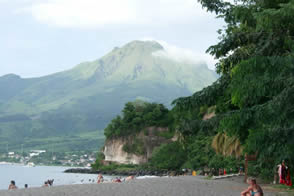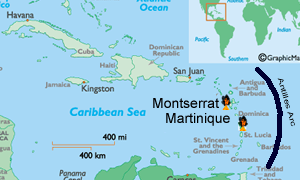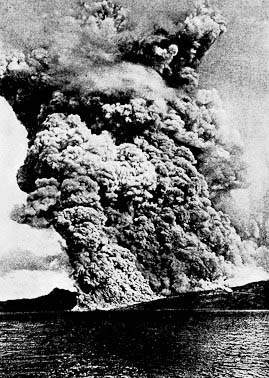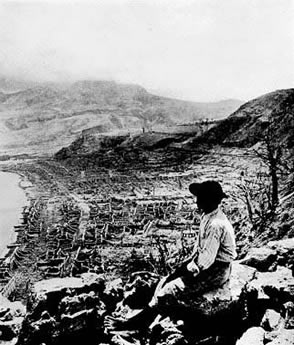Mont Pelee:Martinique
World volcano Profiles >Caribbean Volcanoes>Mt Pelee Martinique
 Mont Pelee(1379m / 4583 ft) is a volcano on the island of Martinique and erupted dramatically in 1902. On the northern tip of the Lesser Antilles island of Martinique it is considered the most regularly active volcano in the Caribbean.
Mont Pelee(1379m / 4583 ft) is a volcano on the island of Martinique and erupted dramatically in 1902. On the northern tip of the Lesser Antilles island of Martinique it is considered the most regularly active volcano in the Caribbean.
Pelee means bald in French and this probably refers to the denuded volcanic landscape the first French settlers saw in 1635. Martinique is one of the remaining outposts of France in the world and you can have proper croissants that taste as good as the one in France after a dip in the Caribbean. The volcano was last active 1930. In 1902 a catastrophic eruption destroyed the beautiful town of St.Pierre killing 30 000 people.
The Geology Bit
 Martinique owes its existence to volcanic acivity and is part of the Antilles Island Arc. Formed due to the subduction of oceanic crust of the North American Plate beneath the Caribbean Plate in a WSW direction at a rate of 2.2cm/year. As the oceanic plate descends magma is generated which gradually works its way to the surface ans ecentually erupts as a volcano.
Martinique owes its existence to volcanic acivity and is part of the Antilles Island Arc. Formed due to the subduction of oceanic crust of the North American Plate beneath the Caribbean Plate in a WSW direction at a rate of 2.2cm/year. As the oceanic plate descends magma is generated which gradually works its way to the surface ans ecentually erupts as a volcano.
The oldest rocks on the island are 24 million years old and there are 8 volcanic centres. The Chemistry of the erupted rocks implies that the magmas for each centre came from different sources. The oldest lavas are andesitic lavas with a strong influence from tholeiitic magma which is high in Iron and Magnesian (tholeiitic melts are the same source and compostion as basalt lavas, same as oceanic crust). Around 16 million years ago melts became more calc-alkaline and richer in silica with more andesite erupted. This second phase is more typical of a mature volcanc arc.
Mt. Pelee is a 400,000 year old stratovolcano and was formed mostly by violent explosive eruptions. The Nuee Ardentes of pyroclastic flows have been caused by dome collapse ( as on Montserrat) and eruption column collapse , where the upward eruption of material in a cloud cannot be maintained and the material collapses back to earth. Both types produce Nuee Ardentes or pyroclastic flows and the associated pumice ignimbrite deposits of ash and ejecta. The 1902 eruption was probably a lateral blast which contained little material but was composed of superheated steam,gas and some ash. Over the last 5000 years the volcano has alternated between Nuee Ardente and Plinian eruptions around every 750 years.
USGS: Mt.Pelee
How volcanoes work: Mt.Pelee
The 1902 eruption
 On May 8 1902 Mt.Pelee unleashed an eruption which killed 30 00 people. Probably the highest volcanic death toll in modern times. Volcanology was in its infancy in the 1800s and the previous stirrings of the volcano in 1792,1851 and 1889 were considered nothing to be concerned about. In February 1902 sulphurous gases killed birds and in April earthquakes shook the mountain and the first eruption cloud covered residents in ash.
On May 8 1902 Mt.Pelee unleashed an eruption which killed 30 00 people. Probably the highest volcanic death toll in modern times. Volcanology was in its infancy in the 1800s and the previous stirrings of the volcano in 1792,1851 and 1889 were considered nothing to be concerned about. In February 1902 sulphurous gases killed birds and in April earthquakes shook the mountain and the first eruption cloud covered residents in ash.
If this had happened in modern times then evacuation and close monitoring would have been organised but in 1902 the Martinique government had more pressing matters to attend to. The elections to decide who controlled the island. The ruling Progressive party wanted to maintain white control of the island and were being rivalled by a black candidate from the Radical party. In St.Pierre a the Progressive Party had won but not by a clear enough majority so another vote had to be organised for May 11.
On May 2 the volcano rumbled and showered the countryside with ash a glow was seen at the summit. People came to St.Pierre to escape the worst of the ash. A Martinique newspaper assured residents that there was no real danger and even organised a boat excursion to see the volcano on May 4.
On May 3 and 4 people watched the fireworks from the volcano. Food and fresh water were running low but the residents stayed on because of the election and reassurances that all was well! A mudflow engulfed a sugar mill and killed 23 people . When it entered the sea it caused a Tsunami which inundated the water front area killing 68 people. Soldiers were now brought in to prevent people leaving the city!The local population turned to Voodoo rituals for help.
On wednesay the 7th Nuee Ardent clouds flowed down the mountain but injured no one as the villages were by now empty. The Italian ship Orsalina was due to sail on the 8 but here captain sailed a day early leaving his passengers behind.
On the Morning of May 8 at 7.50am, as people were going to the Ascension Day services, a black cloud raced down the volcano at an estimated speed of 600km/hour and engulfed St.Pierre. A giant eruption cloud covered the sky for a 50 mile radius. The Governor ,his wife , The American consul ,his wife and the British consul were all killed as were 29 000 other residents.
 The city was probably destroyed by a thin and rapidly moving Pyroclastic surge which came out laterally from the volcano. Only a few cms of ash was deposited so it seems the surge was probably only part of the explosion and the part of the eruption Nuee Ardente did not reach the town,as more rocks and a thicker deposit would have been left.(similar to Mt.St.Helens). The blast was composed of gas,steam and dust and was probably around 1000 C .
The city was probably destroyed by a thin and rapidly moving Pyroclastic surge which came out laterally from the volcano. Only a few cms of ash was deposited so it seems the surge was probably only part of the explosion and the part of the eruption Nuee Ardente did not reach the town,as more rocks and a thicker deposit would have been left.(similar to Mt.St.Helens). The blast was composed of gas,steam and dust and was probably around 1000 C .
The city burnt for several days afterwards. 18 ships with crew and passengers in the harbour were also destroyed. Only 2 people survived on land a shoemaker and a prisoner in a small cell - Cyparis. A British ship managed to limp to St.Lucia with a badly burnt crew.
The volcano carried on erupting violently until the end of August taking another 1000 lives in villages. A tall Spine of lava was extruded from the summit reaching 340m in 1903.
Thankfully modern science can hopefully avoid such disasters happening again. The eruption lent its name to a pelean type of eruption which involves a lateral superheated blast. Not until MtSt.Helens would one be closely studied again.
What to See and How to see it?
First thing to realise is that Martinique is essentially piece of France transplanted into the Caribbean - so some French language phrases will go down well as English is not widely spoken( even if people speak it!) Secondly its a hot and steamy place with a hurricane season through Summer and Autumn. Martinique is a department of France so has the Euro as its currency.
Martinique.org:Official Tourism siteGetting To Martinique
There are International flights from the US.Delta flies from Atlanta. American Airlines ans Air France from Miami . Catamarans run from Guadalope,St.Lucia and Dominca. Car Hire is available from the airport - just remember to drive on the right!
St.Pierre
St.Pierre is a pretty 45-1hour drive along the N2 coastal road from Fort-de France. You can also take a more inland and windy route through the Pitons de Carbet National Park. St.Pierre has been reconstructed since the eruption and lies just 4 miles away from Mt.Pelee.
You can see remains of the old buildings throughout the town. Notable ruins to see are the old theatre whcih seated 800 people and the cell of Cyparis one of the only survivors of the eruption.The collapsed Church of the Fort was where the Ascension Day service was takng place and where all the congregation perished. You can also dive on the wrecks in the harbour. Notably the Roramia which was set on fire and sunk by the explosion.
The Observatoire Volcanoloique de la Montagne Pelee monitors the volcano with a netwok of seismometers and but is unfortunately not open to the public.
The Musee Vulcanologique is worth a visit to see artifacts from the eruption.
Ascent of Mt.Pelee
The most popular route starts from a car park at 830m ( 2700ft) near the village of Le Precheur on the western slopes of the volcano on the D39 or" Route de L'Aileron" and should take 3-5 hours to ascend and descend. The path is well maintained and climbs over old deposits,domes and andesie flows to the summit crater. The 1902 and 1929 domes sit within the crtaer and are largely composed of andesite blocks.The domes are already covered in vegetation. The summit is the top of the 1929 dome. The top of Mt.Pelee shows little activity and there is a distinct lack of steam or sulphur. Climbing a mountain in the tropics can be hot steamy work so take plenty of water and try to walk in the cooler morning. The summit may be shrouded in cloud at any time of day but more likely the afternoon. The sun sets quickly in the tropics so try to avoid watching the sunset from the summit- you will be stumbling down in the dark.
Another interesting walk is up La Coulee Blanche on the SW side of the volcano andstarts about 1km outside S.tPierre. Nuee Ardentes funelled down this valley in 1902 and 1929 and the cliffs are whiter than white pumice . You can even bathe in the river before reaching a waterfall.
Martinique.org:Official Tourism siteNouvelleAntilles.com:Travelguide,bookings,hotels,flights
Travelwizard.com
Fodors: Martinique guide
Zananas-martinique.com: Tourist info
Mount-pelee.com


